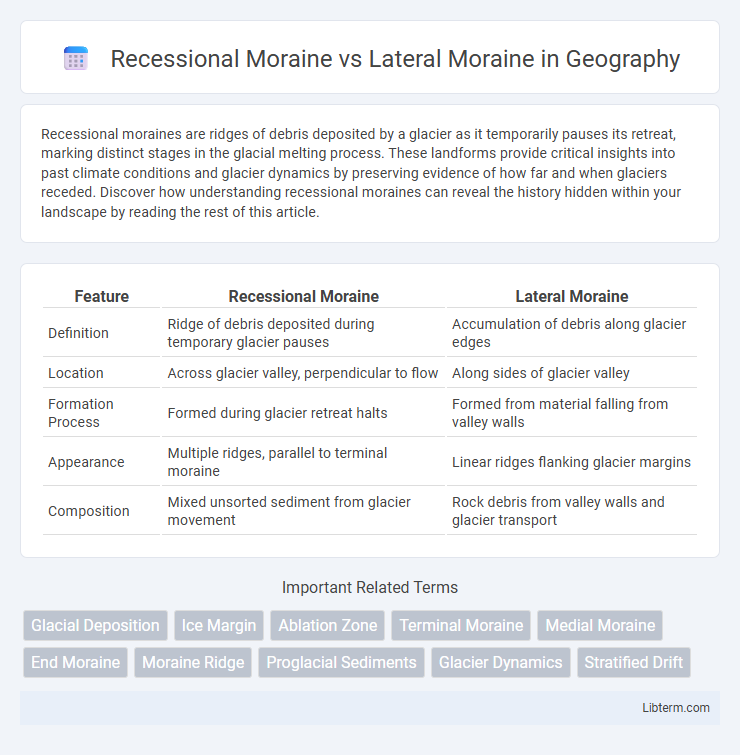Recessional moraines are ridges of debris deposited by a glacier as it temporarily pauses its retreat, marking distinct stages in the glacial melting process. These landforms provide critical insights into past climate conditions and glacier dynamics by preserving evidence of how far and when glaciers receded. Discover how understanding recessional moraines can reveal the history hidden within your landscape by reading the rest of this article.
Table of Comparison
| Feature | Recessional Moraine | Lateral Moraine |
|---|---|---|
| Definition | Ridge of debris deposited during temporary glacier pauses | Accumulation of debris along glacier edges |
| Location | Across glacier valley, perpendicular to flow | Along sides of glacier valley |
| Formation Process | Formed during glacier retreat halts | Formed from material falling from valley walls |
| Appearance | Multiple ridges, parallel to terminal moraine | Linear ridges flanking glacier margins |
| Composition | Mixed unsorted sediment from glacier movement | Rock debris from valley walls and glacier transport |
Introduction to Glacial Moraines
Glacial moraines are accumulations of debris deposited by glaciers, with recessional moraine forming as a glacier temporarily halts during its retreat, creating ridges perpendicular to ice flow. Lateral moraine develops along the glacier's sides, consisting of debris that falls from valley walls and is carried along the glacier's edges. Both types of moraines provide important geological records of past glacier dynamics and movement patterns.
What is a Recessional Moraine?
A recessional moraine is a ridge of debris deposited by a glacier at a temporary standstill during its retreat, marking past positions of the glacier's terminus. Unlike lateral moraines, which form along the sides of a glacier, recessional moraines develop perpendicular to the glacier's flow direction. These moraines are important geological indicators of glacier dynamics and past climate conditions.
What is a Lateral Moraine?
A lateral moraine is a ridge of debris deposited along the sides of a glacier, formed by the accumulation of rock and sediment that falls from valley walls during glacial movement. Unlike recessional moraines, which are formed at pauses in the glacier's retreat and typically span the width of the valley, lateral moraines run parallel to the glacier's flow and mark its edges. These moraines provide critical information about past glacier extents and the dynamics of glacial erosion.
Formation Processes: Recessional vs Lateral Moraines
Recessional moraines form as glaciers temporarily halt their retreat, depositing ridges of debris at various points along the glacier's path. Lateral moraines develop along the sides of a glacier, created from accumulations of rock and sediment that fall from valley walls due to glacial erosion. Both types reveal distinct glacial movement patterns and sediment transport processes critical to understanding past glacier dynamics.
Key Differences Between Recessional and Lateral Moraines
Recessional moraines form at pauses in a glacier's retreat, marking previous ice front positions, while lateral moraines develop along the glacier's sides from accumulated debris. Recessional moraines are typically found perpendicular to the glacier's flow direction, contrasting with lateral moraines that run parallel to glacier margins. The composition of recessional moraines reflects temporally deposited material during glacial retreat, whereas lateral moraines contain debris continuously scraped from valley walls.
Geographic Locations and Examples
Recessional moraines form behind the terminal moraine as glaciers retreat, commonly found in regions like the Wisconsin Glacier in North America and the European Alps. Lateral moraines, composed of debris deposited along the glacier's edges, are prominent in areas such as the Southern Alps of New Zealand and the Rocky Mountains in Canada. These geographic locations provide clear examples of how glacier dynamics influence moraine formation and landscape evolution.
Impact on Landscape and Ecosystems
Recessional moraines form as glaciers temporarily pause during their retreat, creating ridges that shape valleys and influence water drainage patterns, which can form new habitats for diverse flora and fauna. Lateral moraines accumulate along glacier sides, creating distinct ridge formations that alter slope stability and promote unique microenvironments supporting specialized plant and animal communities. Both moraine types significantly impact soil composition and hydrology, driving ecosystem succession and biodiversity in glacially influenced landscapes.
Scientific Importance in Glaciology
Recessional moraines mark pauses in glacier retreat, providing crucial data on the historical dynamics and episodic stability of ice margins, essential for reconstructing paleoclimate conditions. Lateral moraines form along glacier sides, recording the glacier's width and flow patterns, thus offering insights into glacier morphology and ice mass balance over time. Both moraine types serve as vital indicators in glaciology for understanding glacier behavior, sediment transport, and climate interactions throughout glacial periods.
Methods for Identifying Moraines in the Field
Recessional moraines are identified in the field by locating ridges of debris deposited at pauses in a glacier's retreat, often characterized by their position transverse to the glacier's flow. Lateral moraines are found along the sides of a glacier, marked by accumulations of rock and sediment that reflect past glacier margins. Field methods include mapping moraine alignments using GPS, observing sediment size and composition, and examining vegetation patterns to distinguish between recessional and lateral moraines.
Conclusion: Understanding Glacial Features
Recessional moraines mark pauses in a glacier's retreat, forming ridges perpendicular to ice flow that indicate periods of stability, while lateral moraines run parallel along glacier edges, composed of debris deposited from valley walls. Distinguishing these moraines provides insight into glacial dynamics, past climate conditions, and sediment transport. Mastery of these features enhances geological mapping and supports research in paleoenvironmental reconstruction and glaciology.
Recessional Moraine Infographic

 libterm.com
libterm.com